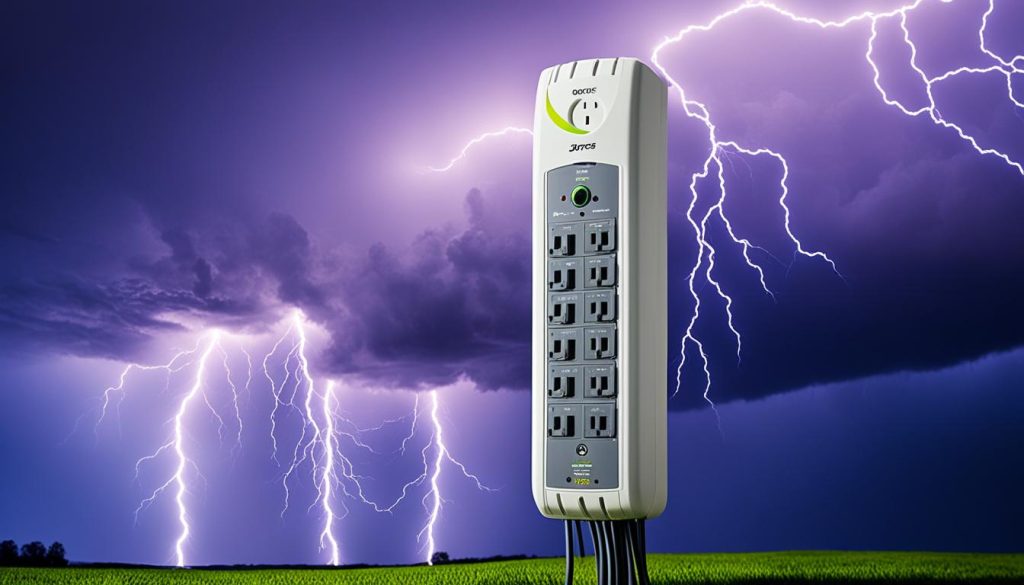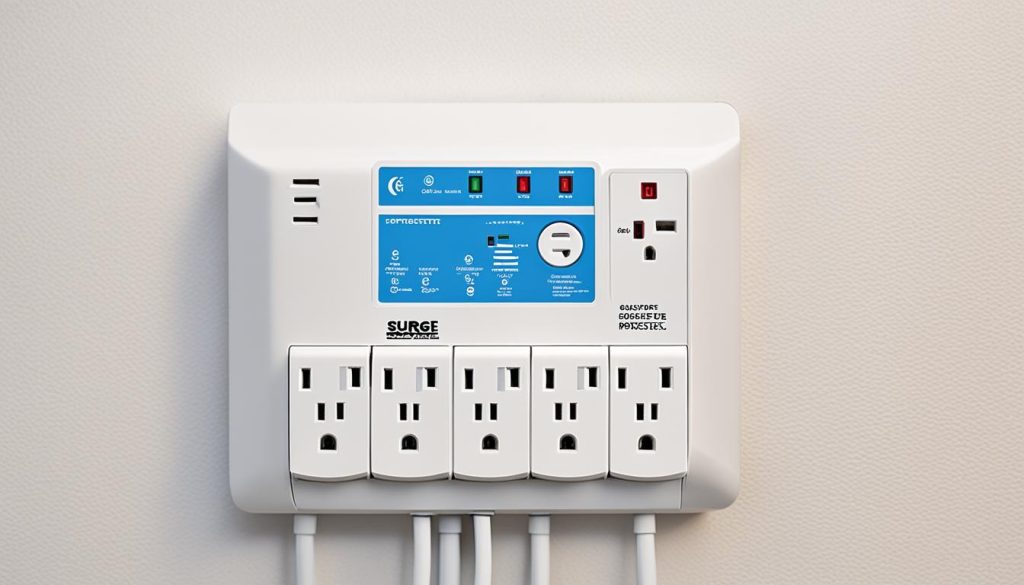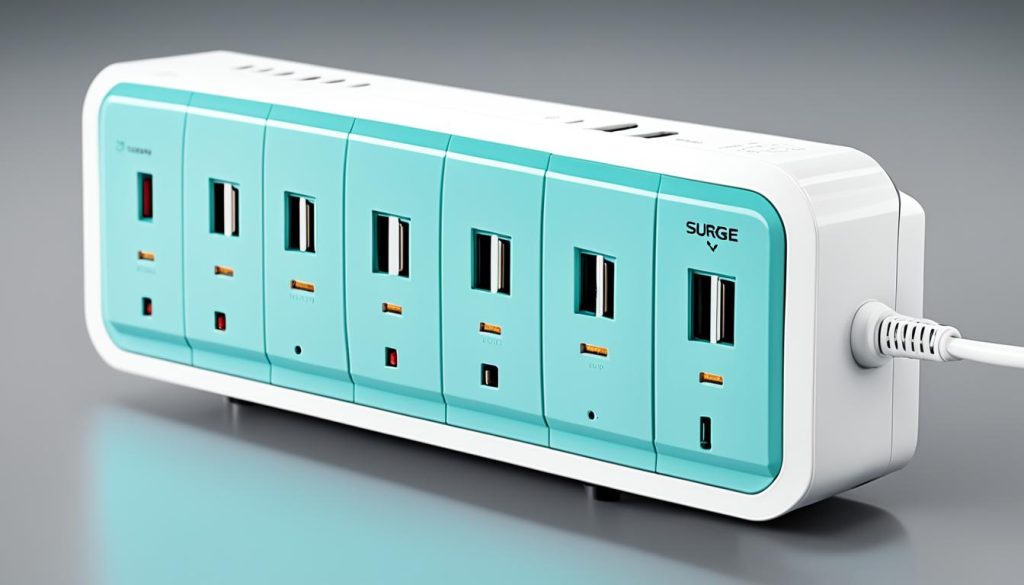Protecting your valuable electronics from power surges and fluctuations is crucial, and having a good surge protector is the key to ensuring their safety. When it comes to choosing a surge protector, there are several important features and factors to consider. In this buying guide, we will explore these features in more detail and provide you with the information you need to make an informed decision.
Key Takeaways:
- Understanding the features and specifications of surge protectors is essential before making a purchase.
- Joule rating indicates the level of surge voltage a protector can absorb, with higher ratings offering better protection.
- Metal oxide varistors (MOVs) are responsible for absorbing and diverting excess current away from connected devices.
- Additional considerations include let-through voltage, circuit breakers, and EMI/RFI noise filtering.
- Choose a surge protector that suits your specific needs, such as one for home use or high-end setups.
Understanding Surge Protector Features
Surge protectors are essential devices for safeguarding your valuable electronics from power surges and fluctuations. To ensure you select the right surge protector for your needs, it’s important to understand the various features that contribute to their effectiveness.
Joule Rating
One of the key specifications to consider is the joule rating. The joule rating indicates the amount of surge voltage the protector can absorb before it becomes overwhelmed. A higher joule rating provides greater protection against power surges. A surge protector with a joule rating of 1000 or more is considered to provide high-level protection.
Metal Oxide Varistors (MOVs)
Metal oxide varistors, or MOVs, are components within surge protectors that help absorb and divert excess current away from your devices, safeguarding them from power surges. MOVs act as a barrier, preventing potential damage to your electronic equipment.
EMI/RFI Filtering
Surge protectors with EMI/RFI filtering capabilities are designed to minimize line noise, such as electromagnetic interference (EMI) and radio frequency interference (RFI). This filtering ensures that your connected devices receive clean and stable power, reducing the risk of malfunctions or data errors caused by line noise.
Automatic Shutoff
An automatic shutoff feature is a crucial safety measure in surge protectors. In the event of a power surge that compromises the surge protector, the automatic shutoff prevents power from reaching your devices. This feature helps protect your electronic equipment from potential damage.
Power over Ethernet (PoE)
Some surge protectors have Power over Ethernet (PoE) capability, allowing them to provide power and network connectivity to certain devices, such as IP cameras, wireless access points, and VoIP phones. This feature eliminates the need for separate power adapters, providing a convenient and efficient solution for your network-connected devices.
Understanding these surge protector features, such as joule rating, MOVs, EMI/RFI filtering, automatic shutoff, and PoE capability, will help you make an informed decision when choosing the right surge protector to protect your valuable electronics.
| Feature | Description |
|---|---|
| Joule Rating | Indicates the amount of surge voltage the protector can absorb before it becomes overwhelmed. |
| Metal Oxide Varistors (MOVs) | Components that absorb and divert excess current away from your devices, protecting them from power surges. |
| EMI/RFI Filtering | Filters out line noise, such as electromagnetic and radio frequency interference, ensuring clean and stable power for your devices. |
| Automatic Shutoff | Shuts off power to devices when the surge protector is compromised, preventing potential damage. |
| Power over Ethernet (PoE) | Provides power and network connectivity to PoE-compatible devices, eliminating the need for separate power adapters. |
The Importance of Joule Rating
When it comes to protecting your electronic devices from power surges, one of the most important factors to consider is the joule rating of a surge protector. The joule rating represents the surge protector’s capacity to absorb and suppress power surges, making it a vital specification to evaluate before making a purchase.
A higher joule rating indicates a surge protector’s ability to handle larger power surges without failing or compromising the connected devices. It measures the amount of energy that the surge protector can absorb and divert safely away from your electronics. A surge protector with a higher joule rating offers better defense against power surges and spikes that could potentially cause irreparable damage to your valuable devices.
For optimal protection, it is recommended to choose a surge protector with a joule rating of at least 1000 or higher. This level of protection ensures that the surge protector can handle significant power spikes and provide a stable power supply to your electronics.
Surge protectors with lower joule ratings, typically ranging from 400 to 600 joules, provide minimal protection against power surges. While they may still offer some level of safeguarding, they are more suitable for smaller electronics or appliances that are not as sensitive to voltage fluctuations.
Investing in a surge protector with a higher joule rating is particularly beneficial if you live in an area prone to frequent power surges or experience electrical disturbances frequently. These surge protection devices offer peace of mind by acting as a barrier between your electronics and unexpected power events.
Remember, power surges and spikes can occur due to various reasons, including lightning strikes, utility grid fluctuations, or even when large appliances in your home cycle on and off. By utilizing a surge protector with a higher joule rating, you mitigate the risk of potential damage and extend the lifespan of your electronic devices.

Benefits of Surge Protectors
Surge protectors offer several benefits that make them essential in protecting your electronic devices:
- Prevent Equipment Damage: Surge protectors safeguard your devices from power surges and spikes, preventing costly repairs or replacements.
- Extend Device Lifespan: By providing a stable power supply, surge protectors prolong the lifespan of your electronics by preventing damage caused by rapid voltage changes.
- Protect Data Loss: Power surges can lead to data loss or corruption. Surge protectors help preserve important files and prevent data loss.
- Safeguard Investments: Electronics are significant investments. Surge protectors protect your financial investment by minimizing the risk of damage during power fluctuations.
- Peace of Mind: Knowing that your devices are protected from power surges gives you peace of mind and allows you to focus on using your electronics without worry.
Investing in a surge protector with a higher joule rating ensures you enjoy these benefits and maintain the longevity of your electronic devices.
“A higher joule rating in a surge protector provides better defense against power surge events, safeguarding your valuable electronic devices from potential damage or loss.”
– Surge Protection Specialist
Comparing Joule Ratings of Surge Protectors
| Surge Protector Model | Joule Rating |
|---|---|
| Brand X Surge Protector | 600 Joules |
| Brand Y Surge Protector | 1000 Joules |
| Brand Z Surge Protector | 2000 Joules |
As seen in the table above, different surge protectors offer varying joule ratings, allowing you to choose the right level of protection for your specific needs. Consider the value and importance of your electronic devices when selecting a surge protector, as investing in a higher joule rating can provide enhanced security and peace of mind.
The Role of MOVs in Surge Protection
Metal oxide varistors (MOVs) are an essential component of surge protectors. They play a crucial role in protecting your electronic devices from power surges by absorbing and diverting excessive voltage. When a power surge occurs, MOVs act as a barrier, preventing the surge from reaching your connected devices and causing damage.
MOV surge protectors are designed to handle high-voltage fluctuations. These surge protector components are made of metal oxide materials and are connected between the power source and your devices. They function by diverting excess voltage to the ground wire, neutralizing the surge before it reaches sensitive electronics.
By absorbing the energy of the surge, MOVs protect your devices against sudden voltage spikes that could otherwise lead to malfunction or irreparable damage. They are like the guardians of your electronics, shielding them from the harmful effects of power surges.

Here’s a breakdown of how MOVs work:
| Surge Diverter | Surge Absorber |
|---|---|
| MOV diverts excessive voltage away from devices | MOV absorbs the energy of the power surge |
| Prevents surge from reaching connected devices | Neutralizes excess voltage |
| Acts as a barrier to protect electronics | Helps prevent damage to sensitive components |
With MOVs working their magic, surge protectors provide an added layer of defense for your valuable electronics. They ensure that power surges are safely diverted and absorbed, allowing your devices to operate without fear of sudden electrical anomalies.
Additional Considerations for Surge Protectors
When choosing a surge protector, there are several factors to consider beyond the joule rating and the presence of MOVs. These additional features and considerations can enhance the protection provided by the surge protector and ensure the safety of your electronic devices.
Let-Through Voltage
The let-through voltage, also known as the clamping voltage, is a critical specification to consider when selecting a surge protector. It indicates the voltage level at which the surge protector begins diverting excess energy away from your devices. A lower let-through voltage provides better protection against power surges and spikes, ensuring that your electronics remain safe.
Circuit Breaker
A surge protector with a built-in circuit breaker adds an extra layer of safety. In case of overload or overcurrent, the circuit breaker automatically cuts off the power supply, protecting your devices from potential damage. This feature is especially useful during power surges or when plugging in high-power appliances.
EMI/RFI Noise Filtering
Electromagnetic interference (EMI) and radio frequency interference (RFI) can cause line noise that interferes with the proper functioning of electronic devices. Surge protectors equipped with EMI/RFI noise filtering technology help eliminate this noise, reducing the risk of malfunctions and data errors. This feature is particularly important for sensitive equipment or environments with high levels of electrical noise.
By considering the let-through voltage, the presence of a circuit breaker, and EMI/RFI noise filtering capabilities, you can choose a surge protector that offers comprehensive protection for your electronic devices.
Surge Protectors for Different Needs
Surge protectors come in different types to meet various needs and usage scenarios. Choosing the right surge protector depends on specific requirements, such as the environment, the number of devices, and the level of protection needed. Here are two common types of surge protectors:
Power Strip Surge Protectors

Power strip surge protectors are ideal for home and personal use. They provide multiple outlets to accommodate everyday electronics, such as computers, televisions, gaming consoles, and chargers. These surge protectors are designed to protect your valuable electronics from power spikes and surges, ensuring their longevity.
“A power strip surge protector is an essential investment for any home or office. It not only protects your electronic devices but also offers convenience with its multiple outlets.” – Jessica Johnson, Tech Expert
The convenience of a power strip surge protector allows you to plug in multiple devices simultaneously, eliminating the need for multiple individual surge protectors. It helps declutter your space while providing comprehensive surge protection for all your electronics.
Rack Mount Surge Protectors

Rack mount surge protectors are designed for more specialized applications, such as data centers, server rooms, and high-end audio/visual setups. They offer protection for multiple pieces of equipment conveniently mounted in a standard rack. These surge protectors provide advanced surge protection for delicate and expensive equipment that requires both power and network connectivity.
“Rack mount surge protectors are essential for keeping your valuable equipment safe from power surges and electrical disturbances. They offer robust protection, ensuring the longevity and performance of your devices.” – Michael Thompson, IT Specialist
Rack mount surge protectors are a reliable solution for businesses and organizations that heavily rely on their equipment’s uninterrupted operation. They safeguard against power fluctuations and surges that can lead to expensive downtime and damage to critical systems.
Whether you need surge protection for your everyday electronics at home or for your professional equipment, choosing the right surge protector is essential for ensuring the safety and longevity of your devices. Consider the specific requirements and usage scenarios to select the most suitable surge protector for your needs.
The Importance of Surge Protector Reliability
When it comes to protecting your valuable electronics, surge protector reliability is paramount. A reliable surge protector not only guards against power surges but also ensures the longevity of your devices. It is essential to understand the lifespan of a surge protector and the importance of timely replacement to maintain optimal protection.
Surge Protectors, like any other electronic device, have a limited lifespan. Over time, they can become less effective in diverting excess voltage and protecting your electronics. It is recommended to replace surge protectors every two to three years, or sooner if you experience power events such as lightning strikes or outages.
Regularly replacing surge protectors helps to ensure that you have the most up-to-date technology and reliable surge protection. Newer models often offer improved features and higher surge absorption capabilities, providing better defense against power surges. By investing in a new surge protector, you are investing in the continued protection of your valuable electronics.
Don’t wait until it’s too late. Protect your electronics and safeguard against power surges by choosing a reliable surge protector and replacing it in a timely manner. Your devices will thank you for it!
FAQ
What are the key features to consider when choosing a surge protector?
When choosing a surge protector, key features to consider include joule rating, MOVs, EMI/RFI filtering, automatic shutoff, and Power over Ethernet (PoE) capability.
What is the importance of joule rating?
Joule rating is crucial as it indicates the surge protector’s ability to absorb surge voltage. Higher joule ratings provide better protection against power surges and spikes.
What role do MOVs play in surge protection?
MOVs (metal oxide varistors) are essential components that absorb surges from the power source and divert them to the ground wire, protecting connected devices from damage.
What are some additional considerations when choosing a surge protector?
Additional considerations include let-through voltage, circuit breaker inclusion, and EMI/RFI noise filtering to enhance protection and minimize malfunctions in electronic devices.
What types of surge protectors are available?
There are different types of surge protectors, including power strip surge protectors for home use and rack mount surge protectors for data centers and audio/visual setups.
How important is surge protector reliability?
Surge protector reliability is crucial for optimal protection. Regular replacement of surge protectors, especially after power events, helps maintain their effectiveness.


